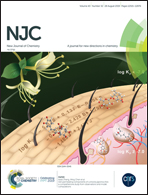The group 9 cyclopentadienylmetal cis-ethylenedithiolates as metallodithiolene ligands in metal carbonyl chemistry: analogies to benzene metal carbonyl complexes†
Abstract
The experimentally known cobalt ethylenedithiolate complex CpCoS2C2H2 as well as its rhodium and iridium analogues are aromatic systems that can function as pentahapto six-electron donor metallodithiolene ligands by binding through all five atoms of its CoS2C2 ring. The lowest energy CpMS2C2H2·Cr(CO)n (n = 3, 2) and CpMS2C2H2·Fe(CO)2 structures (M = Co, Rh, Ir) by substantial margins are predicted by density functional theory to have structures with such pentahapto η5-(CpMS2C2H2) (M = Co, Rh, Ir) ligands. The CpMS2C2H2·Cr(CO)3 structures appear to be favorable as indicated by high carbonyl dissociation free energies (ΔG) exceeding 15 kcal mol−1. The lowest energy structures for the carbonyl-richer CpMS2C2H2·Cr(CO)4 and CpMS2C2H2·Fe(CO)3 systems have trihapto CpMS2C2H2 ligands involving a heterometallic metal–metal bond and two metal–sulfur bonds retaining an uncomplexed C![[double bond, length as m-dash]](https://www.rsc.org/images/entities/char_e001.gif) C double bond in the ethylenedithiolate ligands. The CpMS2C2H2·Fe(CO)3 structures can be derived from the structures of the long-known (RS)2Fe2(CO)6 derivatives by replacing one of the Fe(CO)3 units by an isoelectronic/isolobal CpM unit. Such CpMS2C2H2·Fe(CO)3 structures appear to be favorable as indicated by high carbonyl dissociation free energies (ΔG) exceeding 15 kcal mol−1. Higher energy CpMS2C2H2·Cr(CO)4 and CpMS2C2H2·Fe(CO)3 structures involve coordination of the C
C double bond in the ethylenedithiolate ligands. The CpMS2C2H2·Fe(CO)3 structures can be derived from the structures of the long-known (RS)2Fe2(CO)6 derivatives by replacing one of the Fe(CO)3 units by an isoelectronic/isolobal CpM unit. Such CpMS2C2H2·Fe(CO)3 structures appear to be favorable as indicated by high carbonyl dissociation free energies (ΔG) exceeding 15 kcal mol−1. Higher energy CpMS2C2H2·Cr(CO)4 and CpMS2C2H2·Fe(CO)3 structures involve coordination of the C![[double bond, length as m-dash]](https://www.rsc.org/images/entities/char_e001.gif) C double bond and at least one sulfur atom of the CpMS2C2H2 ligand to the chromium or iron atom but have long metal–metal distances suggesting lack of a direct heterometallic metal–metal bond. In the lowest energy structures of the still carbonyl richer CpMS2C2H2·Cr(CO)5 and CpMS2C2H2·Fe(CO)4 the CpMS2C2H2 ligand is a dihapto ligand that is bonded to the chromium or iron atom through a heterometallic M–M′ (M′ = Cr, Fe) bond and a metal–sulfur bond. Other types of dihapto ligand–metal bonding found in higher energy CpMS2C2H2·Cr(CO)5 and CpMS2C2H2·Fe(CO)4 structures include bonding only the C
C double bond and at least one sulfur atom of the CpMS2C2H2 ligand to the chromium or iron atom but have long metal–metal distances suggesting lack of a direct heterometallic metal–metal bond. In the lowest energy structures of the still carbonyl richer CpMS2C2H2·Cr(CO)5 and CpMS2C2H2·Fe(CO)4 the CpMS2C2H2 ligand is a dihapto ligand that is bonded to the chromium or iron atom through a heterometallic M–M′ (M′ = Cr, Fe) bond and a metal–sulfur bond. Other types of dihapto ligand–metal bonding found in higher energy CpMS2C2H2·Cr(CO)5 and CpMS2C2H2·Fe(CO)4 structures include bonding only the C![[double bond, length as m-dash]](https://www.rsc.org/images/entities/char_e001.gif) C double bond of the ethylenedithiolate ligand to the chromium or iron atom as in a simple (olefin)M(CO)n complex or bonding of adjacent carbon and sulfur atoms in the CpMS2C2H2 ligand to the chromium or iron atom. The latter mode of dihapto C,S bonding of the CpMS2C2H2 ligand can be interpreted as a π-bond from a C
C double bond of the ethylenedithiolate ligand to the chromium or iron atom as in a simple (olefin)M(CO)n complex or bonding of adjacent carbon and sulfur atoms in the CpMS2C2H2 ligand to the chromium or iron atom. The latter mode of dihapto C,S bonding of the CpMS2C2H2 ligand can be interpreted as a π-bond from a C![[double bond, length as m-dash]](https://www.rsc.org/images/entities/char_e001.gif) S double bond in the dithioglyoxal structure for CpMS2C2H2.
S double bond in the dithioglyoxal structure for CpMS2C2H2.



 Please wait while we load your content...
Please wait while we load your content...